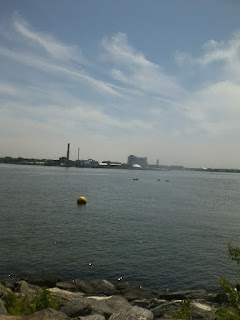It's been called "The Year Without Spring."
Here in New York, people talk--and complain--more than most farmers about the weather. This year, though, they do have reason to complain: Since March, we've had days or weeks when it's been cold and wet punctuated by a day or two of summer-like heat.
Yesterday was one of the few spring-like days we've had, at least temperature-wise. The mild air, though, was humid, probably because of the heavy clouds that covered the area until mid-afternoon, when the sun broke out. Also, we had march-like wind.
So what did I do? I pedaled into that wind--to Connecticut. Yes, I cranked most of the 70 kilometers (43 miles) up to the Nutmeg State into a 30KPH wind. I had to remind myself of that when I arrived, more tired than I'd been on previous rides this year. I thought I'd grown soft over the past couple of weeks, when papers, exams and other end-of-semester duties made me more sedentary than usual.
At the Veterans Memorial in Greenwich, the flowers--and flags--were in full bloom. Unfortunately, my camera wasn't up to the occasion (or I'm the most technologically incompetent person writing a blog today). Fortunately, Arielle was.*
Of course, the ride back was--if you'll pardon the expression--a breeze.
*--I'll be riding more of Dee-Lilah, my new Mercian Vincitore, soon. I have ridden her a couple of times, mainly to test things, but I wanted to save her for the nice weather--and my birthday, for which she is my gift to myself!
Here in New York, people talk--and complain--more than most farmers about the weather. This year, though, they do have reason to complain: Since March, we've had days or weeks when it's been cold and wet punctuated by a day or two of summer-like heat.
Yesterday was one of the few spring-like days we've had, at least temperature-wise. The mild air, though, was humid, probably because of the heavy clouds that covered the area until mid-afternoon, when the sun broke out. Also, we had march-like wind.
So what did I do? I pedaled into that wind--to Connecticut. Yes, I cranked most of the 70 kilometers (43 miles) up to the Nutmeg State into a 30KPH wind. I had to remind myself of that when I arrived, more tired than I'd been on previous rides this year. I thought I'd grown soft over the past couple of weeks, when papers, exams and other end-of-semester duties made me more sedentary than usual.
At the Veterans Memorial in Greenwich, the flowers--and flags--were in full bloom. Unfortunately, my camera wasn't up to the occasion (or I'm the most technologically incompetent person writing a blog today). Fortunately, Arielle was.*
Of course, the ride back was--if you'll pardon the expression--a breeze.
*--I'll be riding more of Dee-Lilah, my new Mercian Vincitore, soon. I have ridden her a couple of times, mainly to test things, but I wanted to save her for the nice weather--and my birthday, for which she is my gift to myself!

















